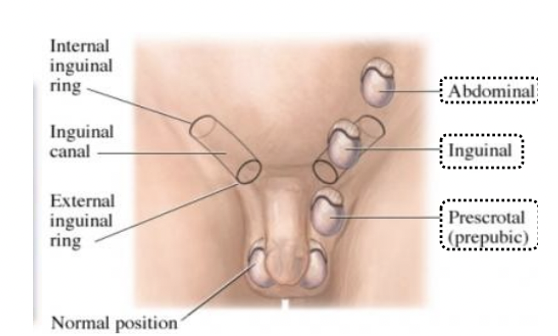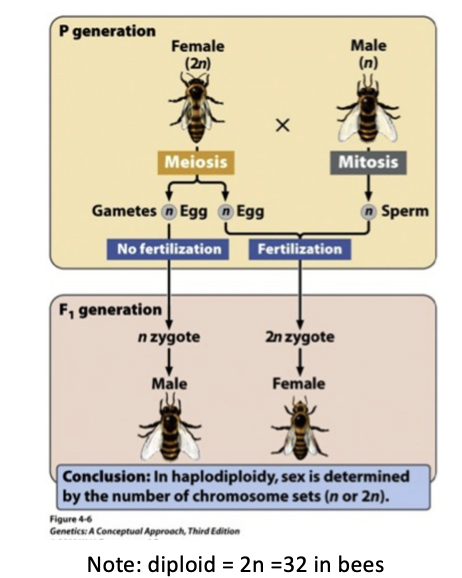Lecture 14: Disorders of Sexual Development
1/15
There's no tags or description
Looks like no tags are added yet.
Name | Mastery | Learn | Test | Matching | Spaced |
|---|
No study sessions yet.
16 Terms
what are disorders of sexual development (DSD)?
- Conditions resulting in discordance between genetic, gonadal, or anatomic sex (internal & external structures) -> intersex individuals
- DSD result from mutations of any of the genes involved in typical sex development or differentiation
- Adequate expression of these genes & proper timing of their expression is important
Ambiguous genitalia
-infant's genital phenotype (external genitals) do not appear to be clearly either male for female
-they used to do surgery straight after birth, often to female but now they need patient consent as there would be long term consequence for affected individuals.
- intersex
SRY translocation
The SRY is located adjacent to the PARS region.
this is the region on the X and Y chromsome that undergoes crossing over during meiosis.
in some rare cases the SRY locus is translocated onto an X chromosome during crossover.
If this sperm containing this translocation fertilises an oocyte → the karyotype will not match the phenotypic expression.
genetically female but phenotypically male.
XX male syndrome
- Female karyotype: 46, XX
- no Y chromosome, so genetically female
- Offspring who inherit the SRY gene on the X chromosome (or translocation to an autosome)
- Formation of both testicles and ovaries in the same individual
- No MIF produced so female internal duct structures present
Swayer Syndrome
- Male karyotype 46, XY
- Y chromosome present, so genetically male
- Y chromosome has accidentally lost the SRY region in crossing over, or gene encoding TDF is mutated making it non-functional
- If no active SRY gene, which encodes TDF, development into a phenotypical female occurs , even though person is genetically male
- Testes hidden in abdominal cavity and a female phenotype
androgen insensitivity syndrome (AIS)
- Male karyotype 46, XY
- Functional SRY gene: TDF expressed, but can have outwardly female phenotype due to an underlying androgen insensitivity syndrome (AIS)
- Testes develop, testosterone is secreted but target cells lack receptors for the androgens - no masculinizing effects occur
- SRY has been shown to interact with the androgen receptor
- Female body type and gender identity but sterile
individuals can have complete or partial AIS
testosterone deficiency
- Male karyotype 46, XY
- Functional SRY region: TDF expressed, MIF expressed
- Can have female phenotype due to Leydig cells in testes not secreting testosterone
- Internal structures and gonads will develop into male structures, but the external genitalia will be female
-> no masculinizing effects occur
- Individuals are sterile and will not go through puberty
5-a-reductase deficiency
- remember, 5-a-reductase-2 acts on testosterone to produce dihydrotestosterone (DHT)
- Male karyotype 46, XY
- Functional SRY region: TDF expressed, MIF expressed, but a 5-α-reductase deficiency
- so, levels of dihydrotestosterone (DHT) very low
- Male internal structures and gonads
- Born with female phenotype or ambiguous genitalia depending on levels of DHT
mullerian inhibiting substance deficiency
- If mutated gene for Mullerian Inhibiting Substance
- Mullerian female ductal structures will not regress
- External genitalia will be male due to presence of testosterone
- Affected individuals usually sterile because testes do not develop normally, and presence of female ducts interferes with sperm transport
True Cryptorchidism
- Absence of one or both testes from the scrotum
- Undescended testicle in 3-4% of boys
- Spermatogenesis: Production of viable sperm, is greatly affected by the temperature of the testicle
- Untreated: Risk of infertility, testicular torsion, cancers

sex determination in Drosophila melanogaster
- seen in the species Drosophila melanogaster
- Y chromosome doesn't carry factors for maleness, so sex is determined by the amount of X chromosomes
- XY = males
- XX = females
- X0 = sterile males
- XXY = females
what is the X0 sex determination system?
- seen in arachnids
- there is only one sex chromosome, the X chromosome (there are no Y chromosomes)
- Sperm of male normally contains either one X chromosome or no sex chromosomes at all
- X0 = male
- XX = female (hermaphrodite)
there are two phenotypes possible:
- male: only has testes, five pairs of autosomes, one single X chromosome
- hermaphrodite: has both testes and ovaries, five pairs of autosomes and two X chromosomes
ZW sex determination system
- in birds
- sex chromosomes are Z and W
- male: homogametic, ZZ
- female: heterogametic, ZW
how can the environment determine sex in species?
reptiles
- In some reptiles, environmental factors determine sex of progeny
- there are no discernible sex chromosomes, nor is their sex determined by the presence or absence of specific genes
- Thermosensitive period of sex development (so, temperature determines the sex)
- Higher temperatures: exponential increase in aromatase activity
aromatase : an enzyme that is responsible for the conversion of androgens into estrogens’s
- Different levels of aromatase activity guide differentiation of the indifferent gonad into an ovary or testis
turtles:
- Eggs incubated above 32°C develop into females
- Eggs below 28°C become male
- Eggs between 28°C-32°C develop into either sex
Alligators
Eggs incubated below 30°C all females
Eggs incubated above 34°C all males
Temperature sensitive period days 7-21
Natural sex ratio 5 females : 1 male
Haplodiploid genetic system - Parthenogenesis
- In insects (e.g. Hymenoptera), unfertilized eggs develop into uniparental haploid males, whereas fertilized eggs into biparental diploid females
- E.g. Ants, bees, wasps

sex change in species
- Female sexual characteristics are substituted for male ones (or vice versa) during lifetime
- Sex change may occur naturally as part of sequential hermaphroditism
- Protandrous hermaphrodites: Organisms that are born male and at some point in their lifespan change sex to female e.g. clown fish
- Protogynous hermaphrodites: Organisms that are born female and at some point in their lifespan change sex to male